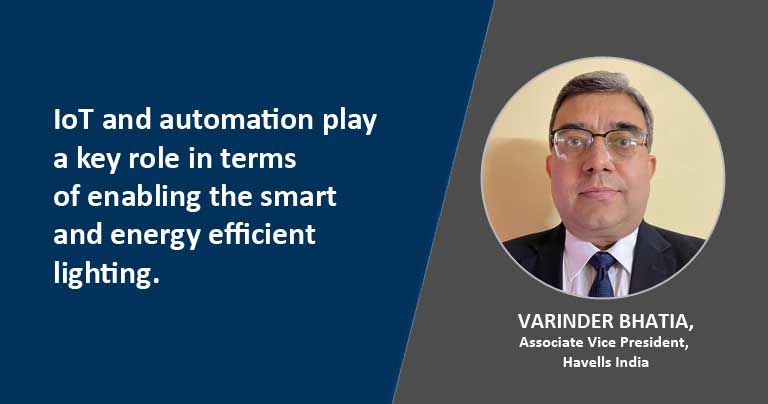It’s time to build strategic measures to enable energy-efficient lighting
By EPR Magazine Editorial November 14, 2021 10:45 am IST
By EPR Magazine Editorial November 14, 2021 10:45 am IST

Communication technologies for sensing and transmitting real-time data that enables quick computation and optimal decision-making to enable smart lighting, says Varinder Bhatia, Associate Vice President Havells India.
How do you view the demand for smart and efficient lighting in commercial and residential segment?
Implementing solar power as an alternative to thermal power is a step in the right direction. Globally, India is emerging as a prominent leader in generation of renewable energy. Along with the government’s initiatives to promote solar power, our country will lead towards sustainability more rapidly. These days the percentage for acceptance of solar rooftop panels is speeding up. There are various reasons that draw one’s attention on the many advantages of installing solar rooftop panels in buildings. The biggest advantage of installing rooftop solar panels is they offer massive cost savings. The tariff rates for rooftop solar in comparison to industrial and commercial tariff rates are cheaper by 25 percent and 35 percent respectively and in some states, it is even 50 percent. It is a secure investment as the price of power generated by solar rooftops will be fixed as compared to fluctuating/increasing tariff from state DISCOMs. It reduces carbon footprint and serves as an affordable source of electricity. It entails extremely less maintenance.
How are the present renewable energy trends impacting the demand for energy-efficient lighting?
Lighting is used extensively in daily life. It is a major factor contributing to our wellbeing and productivity. It enables people to work in homes, offices, buildings and factories. However, lighting equipment consumes resources at every level, while being manufactured, transmission, even while being utilised. At the same time, the ever-growing population and economies will only increase the demand of lighting. Hence, strategic measures that transform markets on the road to higher energy efficiency are required.
Hence, several countries and economies promote energy-efficient lighting solutions by using a combination of regulatory actions, supporting policies, and financial mechanisms. Many countries have effective lighting strategies in place in the form of policies to phase-out inefficient incandescent lamps. Effective lighting is going to directly contribute to the reduction of carbon emissions, resulting into a more sustainable environment and a cost-effective transformation alternative across markets. It is also instrumental in promoting accelerated adoption of more efficient technology and it reduces peak loading as well.How are IT, IoT and automation enabling the industry to meet the demand of energy-efficient lighting for smart cities?
IoT and automation play a key role in terms of enabling smart and energy efficient lighting. It offers a wide number of applications in the energy sector, i.e., in energy supply, transmission and distribution, and demand. IoT contributes majorly to preserving energy as it employs sensors and communication technologies for sensing and transmitting real-time data, which enables fast computations and optimal decision-making. The optimal usage ensures that the lights are aligned with its requirement.
Significant data collection and use of smart algorithms for real time data analysis can help to examine energy consumption patterns of different users and devices in various time scales and keep a check on the consumption accordingly
How is the lighting sector contributing in cutting down the environmental impacts and CO2 emissions?
It is essential for the companies to focus on manufacturing high quality products which entails minimal impact on the environment. In continuation to the previous response, technologies have enabled smart products which are vital to ensure sustainability. It’s easier to drive sustainability through innovations and smarter technologies, the ‘smart’ lighting enables minimum wastage and optimal usage. Also, ensuring maximum safety standards and resource efficiency. The product responsibility begins at the conception and design stage and continues through outthe product’s life cycle.
We use cookies to personalize your experience. By continuing to visit this website you agree to our Terms & Conditions, Privacy Policy and Cookie Policy.